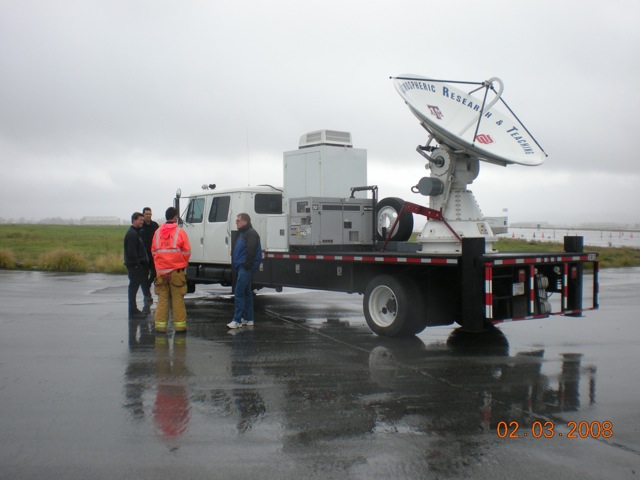The National Weather Service used experimental data from the Shared Mobile Atmospheric and Teaching Radar (SMART-R) in their decision to issue a flash flood warning during last weekend’s storm in southern California. The crew from the National Severe Storms Laboratory provided low-level reflectivity images from the radar every five minutes and transmitted the data to the NWSFO located in Oxnard, CA via a new satellite internet system. The data is being used to supplement local NWS radar coverage where the beam is blocked by mountainous terrain.
The storms of last weekend, January 5-7, 2008 caused record rainfall and the evacuation of an estimated 3,000 Southern California residents in four canyons scarred by wildfires and prone to mudslides. Gauges near the Canyon burn area in Malibu received between 2.16 and 6.6 inches of rain with the storm. The NWS used SMART-R data in their decisions to issue or not issue flash flood warnings. Minor mudslides were reported in Malibu Canyon but well away from any dwellings.
The SMART-R is part of a fleet of high-tech equipment deployed in the Demonstration Flash Flood and Debris Flow Early Warning System project, a joint effort of NOAA and the U.S. Geological Survey. The purpose is to determine how more detailed measurements aid forecasters in issuing flash flood and debris flow warnings. The Canyon Fire burn area near Malibu, CA was the site chosen for intensive research this year, and the surrounding hills are canvassed with streamgauge sensors, real-time webcams and the NSSL-operated SMART-R.
Background: The SMART-R has been provided by NSSL for the last three winter seasons near a burn area that helps provide real-time close-up radar data during rain events. The radar provides reflectivity and estimated one-hour rainfall at the ridgetops of the “research” fire area. The WSR-88D radars in this area are located at mountain sites and precipitation occurring below 10,000 feet remains undetected.
Outcome: Results from the Flash Flood and Debris Flow Project will help public and emergency responders determine flash flood and debris flow hazards in the post-wildfire environment and better serve society’s need for weather and water information, and protect lives and property.
Collaborations: The SMART-R program is a collaborative research program involving NSSL, Texas A&M University, Texas Tech University, and the University of Oklahoma. The group operates two mobile 5-cm Doppler radars to study convective and mesoscale atmospheric processes to help improve forecasts of significant weather events such as flash floods, hurricanes and tornadoes.
More information: http://www.nssl.noaa.gov/research/hydromet/debrisflow.php

